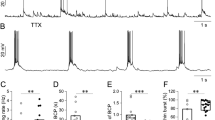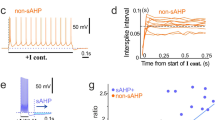Abstract
T-type Ca2+ channels (T channels) underlie rhythmic burst discharges during neuronal oscillations that are typical during sleep. However, the Ca2+-dependent effectors that are selectively regulated by T currents remain unknown. We found that, in dendrites of nucleus reticularis thalami (nRt), intracellular Ca2+ concentration increases were dominated by Ca2+ influx through T channels and shaped rhythmic bursting via competition between Ca2+-dependent small-conductance (SK)-type K+ channels and Ca2+ uptake pumps. Oscillatory bursting was initiated via selective activation of dendritically located SK2 channels, whereas Ca2+ sequestration by sarco/endoplasmic reticulum Ca2+-ATPases (SERCAs) and cumulative T channel inactivation dampened oscillations. Sk2−/− (also known as Kcnn2) mice lacked cellular oscillations, showed a greater than threefold reduction in low-frequency rhythms in the electroencephalogram of non–rapid-eye-movement sleep and had disrupted sleep. Thus, the interplay of T channels, SK2 channels and SERCAs in nRt dendrites comprises a specialized Ca2+ signaling triad to regulate oscillatory dynamics related to sleep.
This is a preview of subscription content, access via your institution
Access options
Subscribe to this journal
Receive 12 print issues and online access
$209.00 per year
only $17.42 per issue
Buy this article
- Purchase on Springer Link
- Instant access to full article PDF
Prices may be subject to local taxes which are calculated during checkout








Similar content being viewed by others
References
Steriade, M. Grouping of brain rhythms in corticothalamic systems. Neuroscience 137, 1087–1106 (2006).
Crunelli, V., Cope, D.W. & Hughes, S.W. Thalamic T-type Ca2+ channels and NREM sleep. Cell Calcium 40, 175–190 (2006).
Contreras, D. The role of T-channels in the generation of thalamocortical rhythms. CNS Neurol. Disord. Drug Targets 5, 571–585 (2006).
Perez-Reyes, E. Molecular physiology of low voltage–activated T-type calcium channels. Physiol. Rev. 83, 117–161 (2003).
Pinault, D. The thalamic reticular nucleus: structure, function and concept. Brain Res. Brain Res. Rev. 46, 1–31 (2004).
Fuentealba, P. & Steriade, M. The reticular nucleus revisited: intrinsic and network properties of a thalamic pacemaker. Prog. Neurobiol. 75, 125–141 (2005).
Domich, L., Oakson, G. & Steriade, M. Thalamic burst patterns in the naturally sleeping cat: a comparison between cortically projecting and reticularis neurones. J. Physiol. (Lond.) 379, 429–449 (1986).
Talley, E.M. et al. Differential distribution of three members of a gene family encoding low voltage–activated (T-type) calcium channels. J. Neurosci. 19, 1895–1911 (1999).
Joksovic, P.M., Bayliss, D.A. & Todorovic, S.M. Different kinetic properties of two T-type Ca2+ currents of rat reticular thalamic neurones and their modulation by enflurane. J. Physiol. (Lond.) 566, 125–142 (2005).
Avanzini, G., de Curtis, M., Panzica, F. & Spreafico, R. Intrinsic properties of nucleus reticularis thalami neurones of the rat studied in vitro. J. Physiol. (Lond.) 416, 111–122 (1989).
Bal, T. & McCormick, D.A. Mechanisms of oscillatory activity in guinea-pig nucleus reticularis thalami in vitro: a mammalian pacemaker. J. Physiol. (Lond.) 468, 669–691 (1993).
Blethyn, K.L., Hughes, S.W., Toth, T.I., Cope, D.W. & Crunelli, V. Neuronal basis of the slow (<1 Hz) oscillation in neurons of the nucleus reticularis thalami in vitro. J. Neurosci. 26, 2474–2486 (2006).
Huguenard, J.R. & McCormick, D.A. Thalamic synchrony and dynamic regulation of global forebrain oscillations. Trends Neurosci. 30, 350–356 (2007).
Pedarzani, P. et al. Control of electrical activity in central neurons by modulating the gating of small conductance Ca2+-activated K+ channels. J. Biol. Chem. 276, 9762–9769 (2001).
Ogden, D., Khodakhah, K., Carter, T., Thomas, M. & Capiod, T. Analogue computation of transient changes of intracellular free Ca2+ concentration with the low affinity Ca2+ indicator furaptra during whole-cell patch-clamp recording. Pflugers Arch. 429, 587–591 (1995).
Destexhe, A., Contreras, D., Steriade, M., Sejnowski, T.J. & Huguenard, J.R. In vivo, in vitro and computational analysis of dendritic calcium currents in thalamic reticular neurons. J. Neurosci. 16, 169–185 (1996).
Debarbieux, F., Brunton, J. & Charpak, S. Effect of bicuculline on thalamic activity: a direct blockade of IAHP in reticularis neurons. J. Neurophysiol. 79, 2911–2918 (1998).
Canepari, M., Auger, C. & Ogden, D. Ca2+ ion permeability and single-channel properties of the metabotropic slow EPSC of rat Purkinje neurons. J. Neurosci. 24, 3563–3573 (2004).
Stocker, M. & Pedarzani, P. Differential distribution of three Ca2+-activated K+ channel subunits, SK1, SK2 and SK3, in the adult rat central nervous system. Mol. Cell. Neurosci. 15, 476–493 (2000).
Bond, C.T. et al. Small conductance Ca2+-activated K+ channel knockout mice reveal the identity of calcium-dependent afterhyperpolarization currents. J. Neurosci. 24, 5301–5306 (2004).
Stocker, M. Ca2+-activated K+ channels: molecular determinants and function of the SK family. Nat. Rev. Neurosci. 5, 758–770 (2004).
Bond, C.T., Maylie, J. & Adelman, J.P. SK channels in excitability, pacemaking and synaptic integration. Curr. Opin. Neurobiol. 15, 305–311 (2005).
Cui, G., Okamoto, T. & Morikawa, H. Spontaneous opening of T-type Ca2+ channels contributes to the irregular firing of dopamine neurons in neonatal rats. J. Neurosci. 24, 11079–11087 (2004).
Richter, T.A., Kolaj, M. & Renaud, L.P. Low voltage–activated Ca2+ channels are coupled to Ca2+-induced Ca2+ release in rat thalamic midline neurons. J. Neurosci. 25, 8267–8271 (2005).
Bildl, W. et al. Protein kinase CK2 is coassembled with small conductance Ca2+-activated K+ channels and regulates channel gating. Neuron 43, 847–858 (2004).
Buzsáki, G. Theta oscillations in the hippocampus. Neuron 33, 325–340 (2002).
Kramár, E.A. et al. A novel mechanism for the facilitation of theta-induced long-term potentiation by brain-derived neurotrophic factor. J. Neurosci. 24, 5151–5161 (2004).
Franken, P., Malafosse, A. & Tafti, M. Genetic variation in EEG activity during sleep in inbred mice. Am. J. Physiol. 275, R1127–R1137 (1998).
Gottesmann, C. The transition from slow-wave sleep to paradoxical sleep: evolving facts and concepts of the neurophysiological processes underlying the intermediate stage of sleep. Neurosci. Biobehav. Rev. 20, 367–387 (1996).
Franken, P., Malafosse, A. & Tafti, M. Genetic determinants of sleep regulation in inbred mice. Sleep 22, 155–169 (1999).
Diana, M.A. et al. T-type and L-type Ca2+ conductances define and encode the bimodal firing pattern of vestibulocerebellar unipolar brush cells. J. Neurosci. 27, 3823–3838 (2007).
Egger, V., Svoboda, K. & Mainen, Z.F. Mechanisms of lateral inhibition in the olfactory bulb: efficiency and modulation of spike-evoked calcium influx into granule cells. J. Neurosci. 23, 7551–7558 (2003).
Ivanov, A.I. & Calabrese, R.L. Intracellular Ca2+ dynamics during spontaneous and evoked activity of leech heart interneurons: low-threshold Ca currents and graded synaptic transmission. J. Neurosci. 20, 4930–4943 (2000).
Munsch, T., Budde, T. & Pape, H.C. Voltage-activated intracellular calcium transients in thalamic relay cells and interneurons. Neuroreport 8, 2411–2418 (1997).
Kuisle, M. et al. Functional stabilization of weakened thalamic pacemaker channel regulation in rat absence epilepsy. J. Physiol. (Lond.) 575, 83–100 (2006).
Frazier, C.J. et al. Gating kinetics of the α1I T-type calcium channel. J. Gen. Physiol. 118, 457–470 (2001).
Uebachs, M., Schaub, C., Perez-Reyes, E. & Beck, H. T-type Ca2+ channels encode prior neuronal activity as modulated recovery rates. J. Physiol. (Lond.) 571, 519–536 (2006).
Ngo-Anh, T.J. et al. SK channels and NMDA receptors form a Ca2+-mediated feedback loop in dendritic spines. Nat. Neurosci. 8, 642–649 (2005).
Marrion, N.V. & Tavalin, S.J. Selective activation of Ca2+-activated K+ channels by colocalized Ca2+ channels in hippocampal neurons. Nature 395, 900–905 (1998).
Kohler, M. et al. Small-conductance, calcium-activated potassium channels from mammalian brain. Science 273, 1709–1714 (1996).
Cai, X. et al. Unique roles of SK and Kv4.2 potassium channels in dendritic integration. Neuron 44, 351–364 (2004).
Pape, H.C., Munsch, T. & Budde, T. Novel vistas of calcium-mediated signaling in the thalamus. Pflugers Arch. 448, 131–138 (2004).
Misquitta, C.M., Mack, D.P. & Grover, A.K. Sarco/endoplasmic reticulum Ca2+ (SERCA)-pumps: link to heart beats and calcium waves. Cell Calcium 25, 277–290 (1999).
Lytton, J., Westlin, M., Burk, S.E., Shull, G.E. & MacLennan, D.H. Functional comparisons between isoforms of the sarcoplasmic or endoplasmic reticulum family of calcium pumps. J. Biol. Chem. 267, 14483–14489 (1992).
Fierro, L., DiPolo, R. & Llanò, I. Intracellular calcium clearance in Purkinje cell somata from rat cerebellar slices. J. Physiol. (Lond.) 510, 499–512 (1998).
Amzica, F., Nunez, A. & Steriade, M. Delta frequency (1–4 Hz) oscillations of perigeniculate thalamic neurons and their modulation by light. Neuroscience 51, 285–294 (1992).
Vyazovskiy, V.V. et al. Sleep EEG in mice that are deficient in the potassium channel subunit K.v.3.2. Brain Res. 947, 204–211 (2002).
Joho, R.H., Marks, G.A. & Espinosa, F. Kv3 potassium channels control the duration of different arousal states by distinct stochastic and clock-like mechanisms. Eur. J. Neurosci. 23, 1567–1574 (2006).
Liguori, R. et al. Morvan's syndrome: peripheral and central nervous system and cardiac involvement with antibodies to voltage-gated potassium channels. Brain 124, 2417–2426 (2001).
Luján, R., Nusser, Z., Roberts, J.D., Shigemoto, R. & Somogyi, P. Perisynaptic location of metabotropic glutamate receptors mGluR1 and mGluR5 on dendrites and dendritic spines in the rat hippocampus. Eur. J. Neurosci. 8, 1488–1500 (1996).
Acknowledgements
We thank M. Tafti, K. Vogt and N. Wanaverbecq for constructive input and A. Reisch for carrying out preliminary electrophysiological experiments. We thank L. Acsády, A. Destexhe, B. Gähwiler, U. Gerber, C. Kopp and D. Ulrich for stimulating discussions and helpful comments on the manuscript. This work was supported by grants from the Swiss National Science Foundation (A.L.), the US National Institutes of Health (P.F. and J.P.A.) and the Spanish Ministry of Education and Science (R.L.).
Author information
Authors and Affiliations
Corresponding author
Supplementary information
Supplementary Text and Figures
Supplementary Figures 1–5, Supplementary Table 1, Supplementary Note and Supplementary Methods (PDF 2441 kb)
Supplementary Movie 1
Fluorescent signals in a dendrite of a nRt neuron filled with the Ca2+ dye magfura-2 during a dampened electrical oscillation. (WMV 482 kb)
Rights and permissions
About this article
Cite this article
Cueni, L., Canepari, M., Luján, R. et al. T-type Ca2+ channels, SK2 channels and SERCAs gate sleep-related oscillations in thalamic dendrites. Nat Neurosci 11, 683–692 (2008). https://doi.org/10.1038/nn.2124
Received:
Accepted:
Published:
Issue Date:
DOI: https://doi.org/10.1038/nn.2124
This article is cited by
-
A Thalamocortical Perspective on Sleep Spindle Alterations in Neurodevelopmental Disorders
Current Sleep Medicine Reports (2024)
-
Sleep spindles in people with schizophrenia, schizoaffective disorders or bipolar disorders: a pilot study in a general population-based cohort
BMC Psychiatry (2022)
-
Diversity and Functional Features of Calcium-Dependent Potassium Channels as Determinants of Their Role in the Plasticity of Cerebral Neurons
Neuroscience and Behavioral Physiology (2021)
-
Effects of a patient-derived de novo coding alteration of CACNA1I in mice connect a schizophrenia risk gene with sleep spindle deficits
Translational Psychiatry (2020)
-
Nodding behavior couples to vigilance fluctuation in a high-calorie diet model of drowsiness
Molecular Brain (2018)



